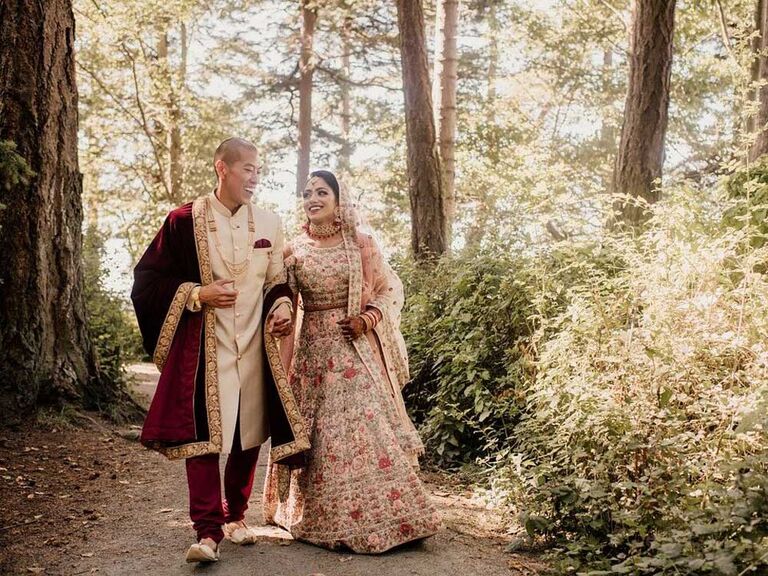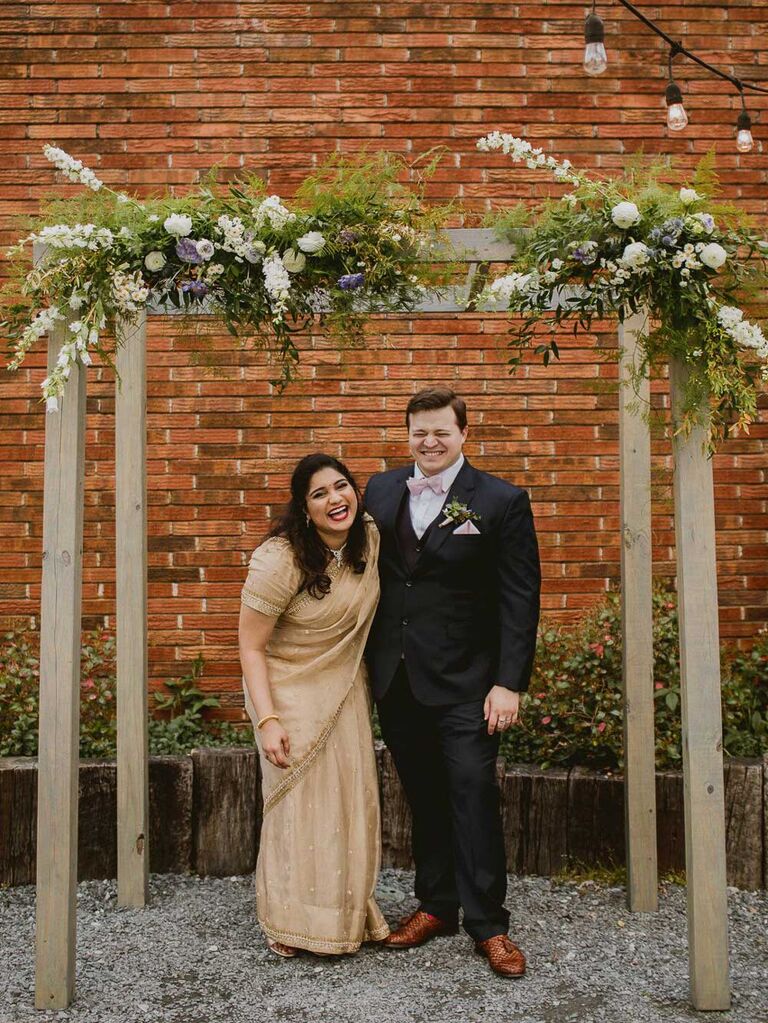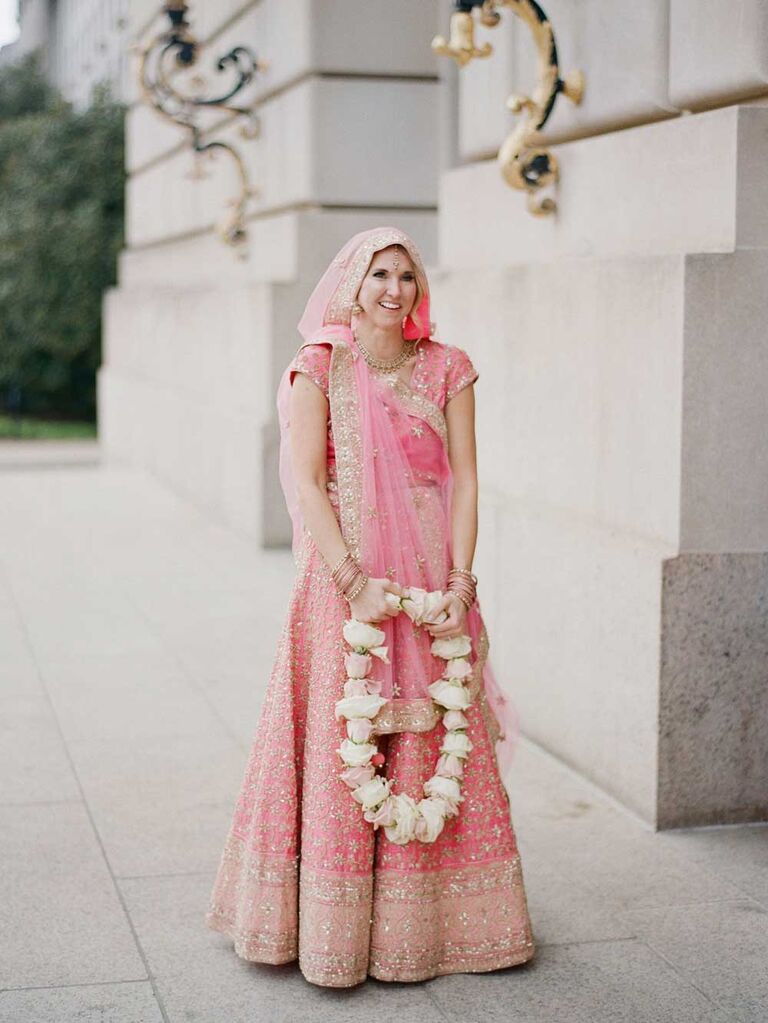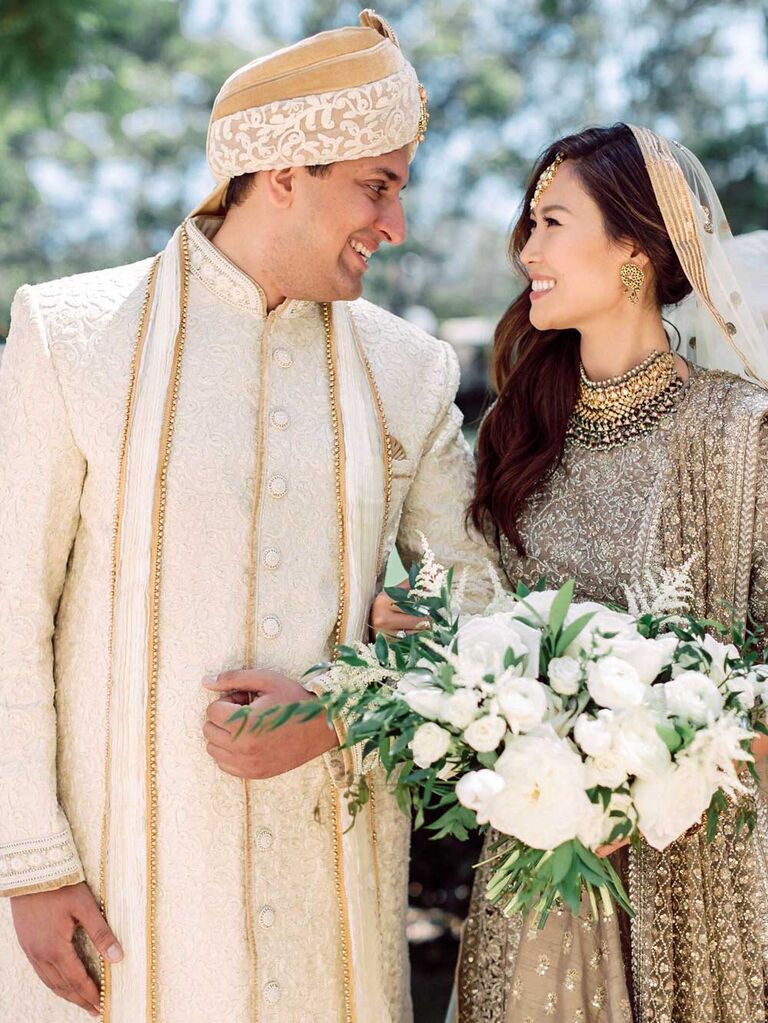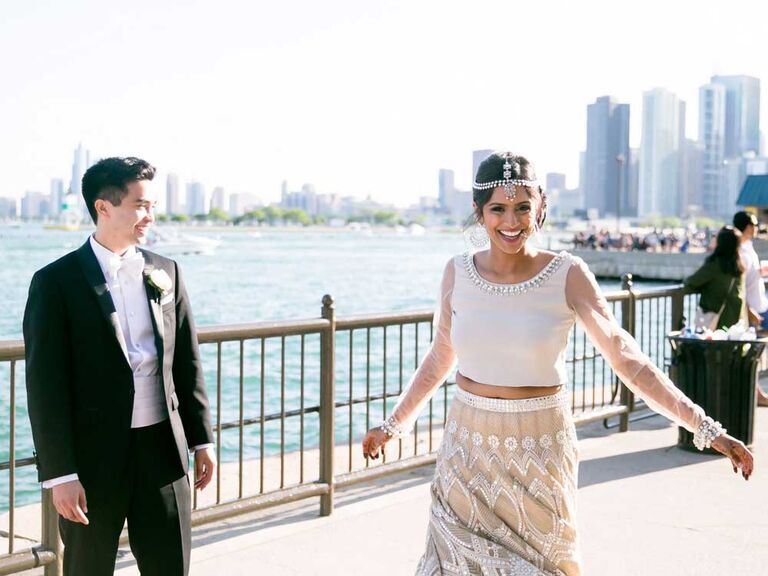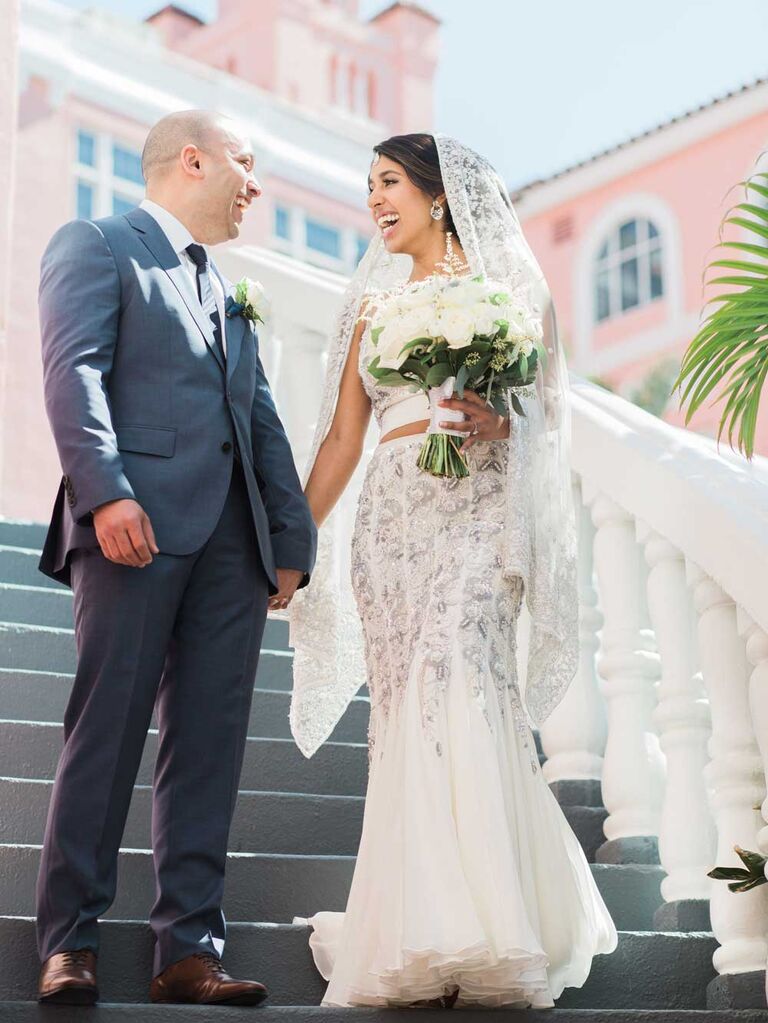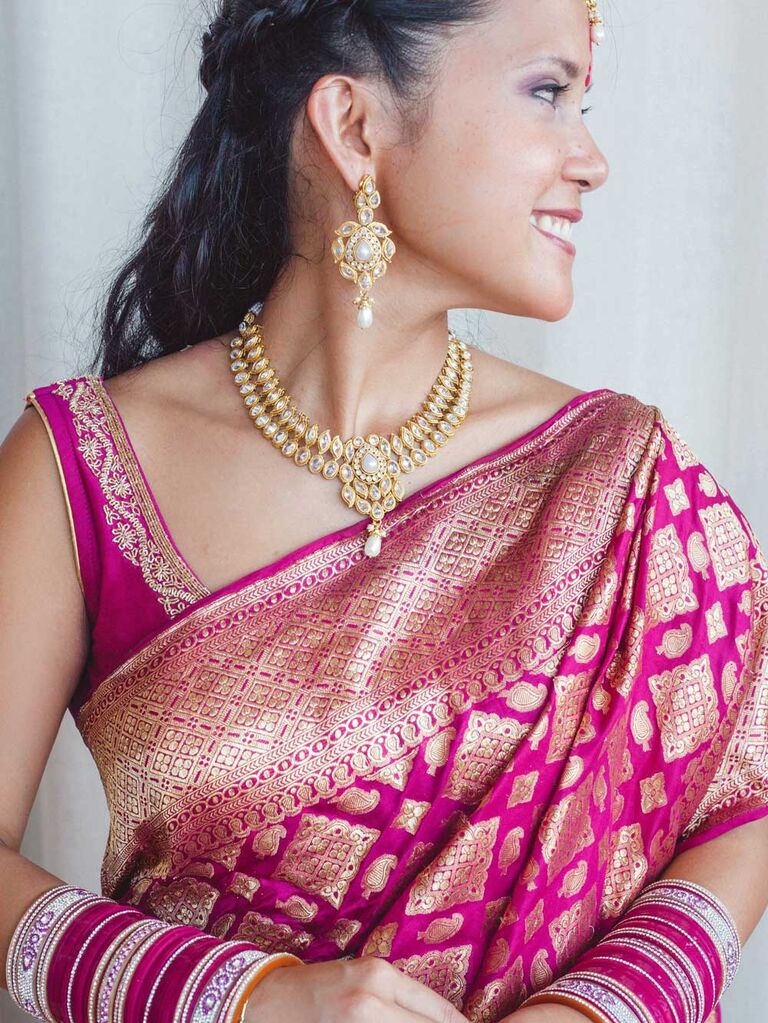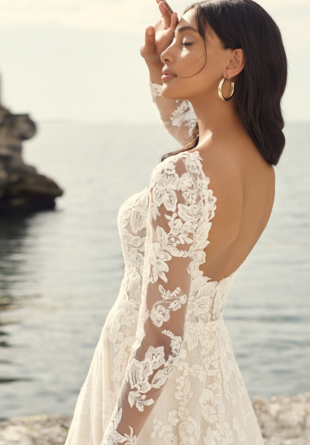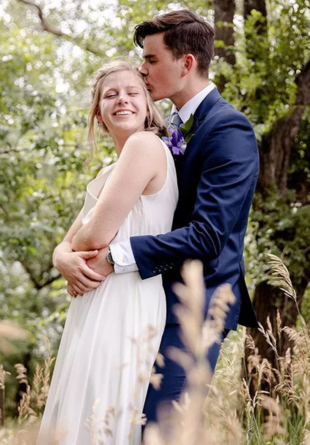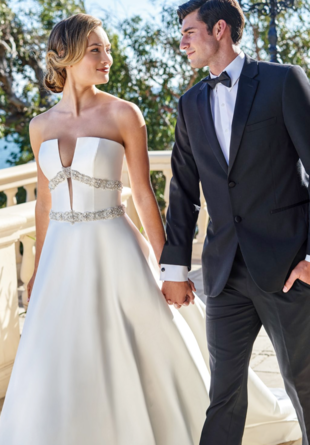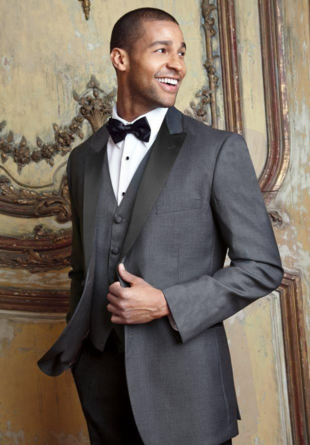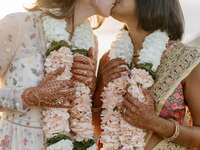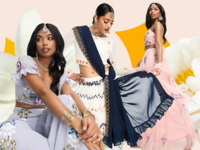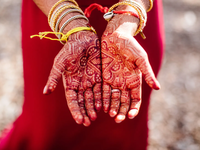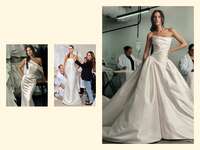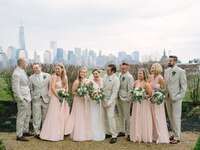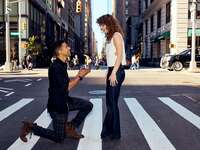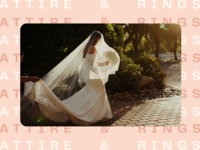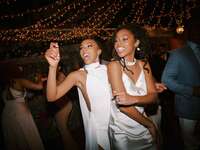The Complete Indian Wedding Dress Guide

Indian wedding dresses are known for their vibrant colors, intricate patterns, and ornate beading. With a rich history inspiring the design, finding a traditional Indian wedding dress that represents your style and culture is of the utmost importance. If you're planning your own Indian or fusion wedding, you might need inspiration to get you started with your gown search.
To help make your dress shopping experience as seamless as possible, we've tapped one of the industry's most well-known designers to explain everything you need to know about Indian wedding dresses. Whether you're in the market for a lehenga and saree set or you need some style inspiration, we break down all there is to know about the cultural significance of different outfit pieces, where to buy them online, and how to accessorize your look so it fits your personality. Plus, we've rounded up our favorite Indian wedding dresses from real brides for maximum inspiration.
Meet Our Expert
- Anita Dongre: Mumbai-born Anita Dongre credits summers spent at her family's home in Jaipur with influencing her choice of career. It was there that Dongre was exposed to the rich world of Indian craft and artisanship, which would ultimately shape the aesthetic of her eponymous brand. Fun fact: when the then Duchess of Cambridge (aka Kate Middleton) wore a dress by Dongre in 2016, the ensuing demand crashed the designer's website. That said, Dongre's reputation as a leading designer in the traditional Indian fashion space had already been firmly established since 2013 with her wares garnering her countless celebrity fans including Kareena Kapoor, Alia Bhatt, and Neha Dhupia have also stepped out in pieces by Dongre.
In this article:
- The Tradition Behind Indian Wedding Dresses
- How to Choose Your Indian Wedding Dress Look
- Where to Buy Your Indian Wedding Dress
- Our Favorite Real Indian Wedding Dresses
The Tradition Behind Indian Wedding Dresses
Indian wedding dresses vary in color, design, and shape—and it's for this reason that traditional looks vary across cultures. "There is no such thing as a standard traditional Indian wedding outfit, and that is the beauty of India's diversity," says designer Anita Dongre. "Every one of the thousands of cultures that make up our national identity has a different set of customs and rituals and different pieces to make up a bridal look."
While your wedding day look is completely up to you, your culture can provide guidance on which pieces to pair together. "Every culture has its own story to tell and that's the beauty of India's rich and diverse cultural traditions," she says.
Parts of a Traditional Indian Wedding Dress
There are commonly named elements of Indian wedding dresses that you'll want to familiarize yourself with before you shop. Traditional attire includes one key look for the wedding ceremony, which could be an ethnic saree (draped per your custom), a bridal lehenga, or a sharara. The bride can also opt for a saree, lehenga, sharara, or ethnic gown for her pre-wedding events like the haldi ceremony, sangeet, or post-wedding reception party. These outfits are further accessorized with traditional jewelry designs, as per the bride's culture.
"Some cultures have a 'nath' (a large nose ring) and maang tikka (a piece of jewelry for the forehead), while others have bejeweled armbands and waistbands." A common Hindu tradition is the Mangalsutra in the north and Thaali in the south. It's a simple neckpiece that the groom ties around the bride's neck as a mark of marriage.
Traditional Wedding Dress Colors
Cultural traditions may dictate the pieces you wear on your wedding day, but certain color palettes are similar for Indian brides throughout the world. "A lot of Indian brides wear red," Dongre shares. "In some cases, it's the whole outfit and in others, it's the border or accessory. Red symbolizes the rising sun and is thus seen as the color of prosperity and fertility."
This hue is often seen in traditional Indian weddings for the good luck it's believed to bring—but red isn't your only color option. Famous Bollywood actors like Anushka Sharma, and Alia Bhatt and content creators like Ahanna Pandey started the trend of pastel lehengas and ivory or white bridal outfits. There is a growing demand for these unique colors in bridalwear outfits now. You can modernize your look by incorporating neutral tones or unexpected color pairings to make your bridal look feel more personal. "More and more Indian brides, however, are taking cues from nature and moving towards happy, breezy colors, especially in the summer," Dongre says. "You'll see lots of lime greens, corals, warm sunshine yellows, bright oranges, and whites."
How to Choose Your Indian Wedding Dress Look
When you're ready to shop for an Indian wedding dress, start by gathering inspiration for your vision. "Given that each Indian family has its own culture, most women look to their mothers and aunts for inspiration," Dongre says. "Another good place for inspiration is Pinterest. In the past, women would scrapbook their inspirations. This is a digital extension of that idea." You can also pull inspiration from Bollywood films and actresses, designer Instagram pages, and real wedding photo albums.
Something to keep in mind while dress shopping is practicality. "A mistake brides can make is not thinking about the weather when they're putting their look together," Dongre advises. "Whether this is with hair and makeup or the lehenga, discuss the location and weather and make practical choices. This is the best thing you can do to make sure you're having a great time and glowing through the function."
Another thing to remember is that your outfit should be a reflection of your personality—not anyone else's. "It's so important to remember that you wear the outfit—the outfit should never wear you," she adds. "I constantly tell brides that they shouldn't look at pictures from their wedding and feel like they're looking at a stranger. You can do that by making meticulous choices in each piece you wear, from the lehenga to your shoes."
How to Accessorize Indian Wedding Dresses
One of the best ways to make your Indian wedding dress reflect your personal style is to accessorize thoughtfully. "Pick one hero piece and build the rest of your pieces around that," Dongre suggests. "If you're wearing large earrings, allow that to shine through without having to compete for attention with a neckpiece or even your outfit."
To keep consistency among your jewels, pick a color palette to work around. "A rule of thumb I suggest is to stick to one metal in an entire ensemble," she adds. "I don't typically recommend pairing yellow metals with white. If you want to wear colored stones, pick a color from your outfit to highlight or contrast your jewelry against."
Another factor to consider is the style of your accessories. If you're itching to experiment with trends (but don't want to fully commit to it for your wedding look), incorporate them into party wear for additional wedding events. "Pick your most elaborate outfit for the wedding and reception and choose easier pieces for the sangeet, haldi, and cocktail events," Dongre suggests. "Tulle skirts, printed lehengas, gowns, and jackets are great choices for the pre-wedding events, while sarees and intricately detailed lehengas and shararas are great for the wedding and reception functions."
Where to Buy Your Indian Wedding Dress
Whether you want the old-school bridal salon experience or the ease of online shopping, there is an Indian wedding dress retailer to meet your needs. Given the myriad cultural influences involved in choosing the perfect dress, brides-to-be would be wise to choose a designer or boutique owner who is well-versed in Indian wedding traditions. Below, we've outlined a couple of the biggest names known to Indian couples, as well as trusted vendors from The Knot Marketplace.
- Aayka Fashion: Not based in NYC? No Problem. This woman-owned boutique in Manhattan offers customers the option to buy—or rent—from any US state. The skilled team can also facilitate collaboration with South Asian artisans to create a design that is unique to you.
- VAMA Designs Indian Bridal Couture: Based in the San Francisco Bay area, VAMA's signature "fusion" designs blend the best of Indian glamour with more Western silhouettes. You'll want to carve out plenty of time when visiting the boutique, as the team carries over 500 ready-to-wear options.
- Anita Dongre: From the lightest silk to weighty luxe velvet, Anita Dongre's Indian wedding dress designs are as unique and varied as the brides who choose them. Don't miss the designer's line of jewelry accessories to finish off your look.
- Sabyasachi: For a traditional Indian wedding dress befitting a maharani, look no further than Sabyasachi Mukherjee. The designer was the creative mastermind behind Priyanka Chopra Jonas's sindoor red ensemble at her 2019 nuptials in Jodhpur.
Our Favorite Real Indian Wedding Dresses
So, now you know how to find and style your bridal look. For even more inspiration, we've rounded up our favorite real wedding photos of Indian wedding dresses. Browse these images to see how brides made their dresses uniquely their own with bold color palettes, modern silhouettes, and extravagant jewels.
Vibrant red and shimmering gold are two of the most common colors to pair together in an Indian bridal look. This traditional lehenga features elegant gold details throughout, which is complemented by red and gold bangles, a gold necklace, and statement earrings. The bride's cascading fishtail braid gives this ensemble a hint of modernity.
Pops of red accent this gold embellished lehenga, which the bride accented with a statement necklace and gold and red earrings. Her sheer gold veil also features red beading and embroidery to match the gown, bringing the entire look together.
This bride's elegant long-sleeved A-line wedding dress is covered in delicate embellishments, which enhance the off-white shade. Subtle pops of green jewelry add depth to her glamorous bridal look.
Indian wedding dresses don't always have to be extravagant to make a statement. This bride opted for a simple gold lehenga, which was paired with a matching saree. The outfit features delicate beading to add a subtle shimmer, which is enhanced with a sparkling necklace and a gold bangle.
You can experiment with color if that's fit to your style. Instead of wearing red, this bride opted for a bright pink lehenga with a matching saree. Both pieces are adorned with gold beading and jewels, while pink and gold bangles bring the ensemble together.

If you're thinking of wearing a lehenga choli (a short crop top), take inspiration from this bride. Her ivory top features a sheer neckline overlay, and the crystal embellishments match those on her bright red skirt. Ornate beading on her sheer red veil corresponds with her jewelry, including her red and diamond bangles that have hanging beads for an extra pop of sparkle.
Even with a stunning backdrop, it's hard to look away from this bride's wedding dress. The ivory bridal lehenga features boho floral embroidery, while her sheer saree drapes from her shoulders to the back of her hair to bring the look together. For those who want to incorporate color without committing to a bright base shade, this look perfectly marries vibrant hues with neutral tones.
Bright colors aren't needed to make a statement—take this bride's outfit for proof. Her captivating bridal look stands out for the intricate beading throughout, which makes every neutral shade pop. Plus, with a bold necklace that complements her earrings and veil, each element comes together to create one unforgettable look.
Don't forget that the back of your Indian wedding dress can be just as stunning as the front. The bride's sheer red veil showcases the back of the bridal lehenga, which features bold cutouts, gold beading, and elegant embroidery.
Perhaps you're looking for reception dress inspiration. This bride traded a traditional lehenga for a simple white dress with floral embroidery on the bodice and skirt. The simple pattern brings bohemian flair to the look, while the embroidery on top is reminiscent of traditional Indian wedding dress style.
Indian wedding dresses with 1920s vibes? Yes, please. This bride's flapperesque lehenga includes a cream top with sheer sleeves and minimal beading on the neckline, while her skirt has an art-deco pattern that's reminiscent of the Jazz Age. A pearl-and-crystal headpiece ties the entire vintage look together.
While lehengas often include loose, full skirts, this design shows that you can customize your look with any silhouette you love. This bride opted for a fitted, mermaid-inspired skirt to pair with her cropped top. The white fabric is adorned with silver beading, while the lace veil adds an elegant touch to this lehenga-inspired outfit.
Go bold with a fuschia Indian wedding dress like this bride. When paired together, gold and fuschia deliver the wow factor that some hope to emulate. The shimmering pattern pairs perfectly with the bride's gold jewelry, while her chunky fuschia bangles finish off her bright look.


